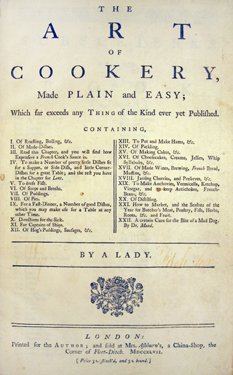Iconic Cookbooks
Previous cases focusing on early printed cookbooks and continental cooking represented early modern cookbooks, written for those moving in court circles or similarly aristocratic venues. The authors represented in this case are iconic for their attempts to demystify "haute cuisine," foreign food, and/or cooking in general, attempting to make recipes accessible to the home cook, a shift that begins in the 18th century. Their audiences were pointedly middle-class, either cooking themselves, or managing a small staff.
In a marked shift from earlier cookery works, two of the most popular books of the century were written by women: Eliza Smith's The Compleat Housewife (1727), Hannah Glasse's The Art of Cookery Made Plain and Easy (1747). Glasse's book enjoyed tremendous popularity, running to seventeen editions by the early nineteenth century. Her recipes were pirated by imitators (although she herself also "borrowed" heavily from Eliza Smith's work). Importantly, Glasse begins providing more specific, precise measurements compared to earlier works.
If Hannah Glasse set the standard for the eighteenth century, by the Victorian period, Isabella Beeton took on this role. Mrs Beeton's Book of Household Management (1861) was a best-seller from the start, and even after Beeton's early death, the title, and persona, carried on into many editions. As its title suggests, Beeton's tome covers not just recipes, but touches on all aspects of the household, from marketing to managing servants, to stylish table settings. And like Glasse, Beeton is further notable for presenting recipes in a style more similar to those we see today, with a list of ingredients, measurements, and directions.
Cookbooks of the eighteenth- and nineteenth centuries were aimed at the well-to-do and aspiring middle class, encouraging the embrace of a higher standard of living and use of the many imported foods and beverages to be had. Yet by the mid-twentieth century, few middle class home cooks had domestic assistance, and women were instead running households and preparing meals entirely on their own. While home cooking was now an established female realm, haute cuisine remained a male sphere, not dissimilar from the world of La Varenne centuries before, when French cooking was influential and men claimed the positions of chef to their aristocratic employers. Julia Child's The Art of French Cooking (1961) sought to demystify French techniques and foods. Her book is filled with illustrations demonstrating techniques, as well as detailed directions designed to enable the home cook to prepare dishes previously considered intimidating to the average American homemaker.
While Child's contributions to cookery history may have been popularizing French cooking, James Beard is important for his embrace and promotion of American food. Beard's books showcase classic American cuisine, from regional favorites to the American love of grilling and barbeque.
This mid-century period also saw the development of a number of notable food writers, such as Elizabeth David in England, and M.F. K. Fisher in the United States. While their books often weave recipes into the work, their writing is more focused on reflections on food as a whole, or on the rituals and pleasures of eating.




